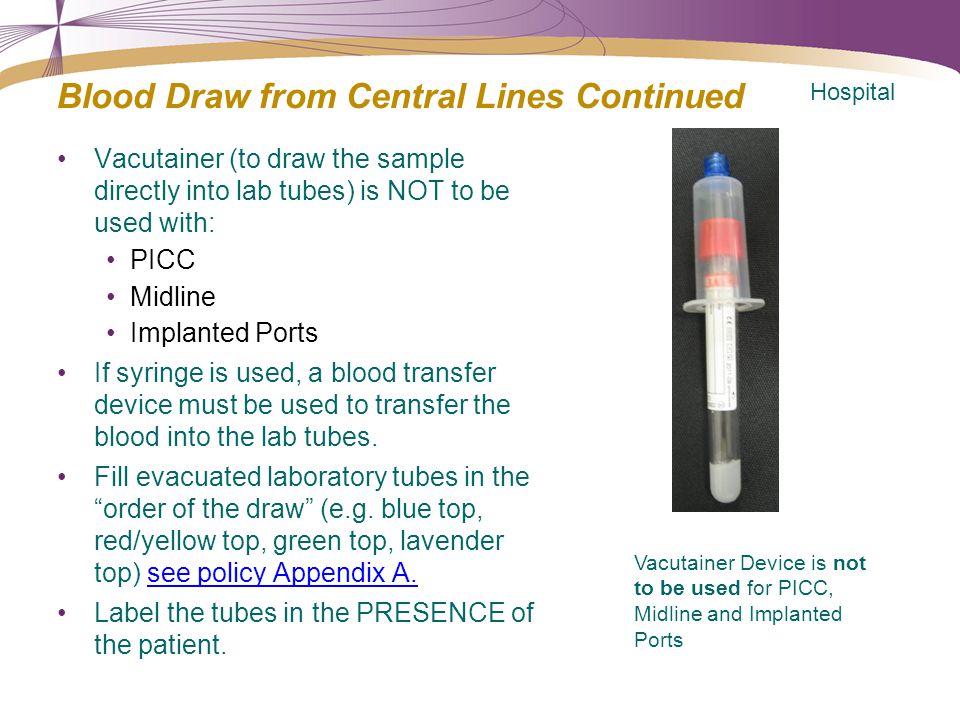Blood Draw Central Line, Web perform a vigorous mechanical scrub of the needleless connector for at least 15 seconds using an antiseptic pad, allow it to dry, connect an empty syringe to the catheter, release the clamp, and withdraw the blood sample.
Blood Draw Central Line - Most patients with a central line had no cultures drawn from their central line. Web however, specimens from central lines carry a risk of contamination or erroneous laboratory test results. This procedure shall be done using aseptic technique. Web this video will demonstrate how to draw blood from a central line according to salem hospital procedure. Types include picc lines and implantable ports. Web a central line is a catheter that is placed into a patient’s large vein, usually in the neck, chest, arms or groin. Web obtaining blood samples, either via a venous stick or from a central line, is a critical nursing skill. Incomplete initial sepsis workups were infrequent and occurred mostly in icus. Web blood draws via central line catheters may be performed only by rns trained in central line. Central venous catheters are placed for various reasons, such as inadequate peripheral venous access, hemodynamic monitoring, infusion of peripherally incompatible infusions, and extracorporeal therapies. Web a central line is an iv (intravenous) line that goes into a large blood vessel near the center of the body. Central to this technique is a. Web blood drawing from indwelling arterial or central venous lines is done through a stopcock with a needleless access device on the sampling port. Multiple manipulations of the catheter (e.g., repositioning). Incomplete. Huber needle (if implanted port) 10ml syringe for specimen. Web drawing blood through a central venous catheter. Web a central line is an iv (intravenous) line that goes into a large blood vessel near the center of the body. Web blood draws via central line catheters may be performed only by rns trained in central line. Web a central line. Without proper specimens, unhelpful or even harmful medical treatment could happen. Most patients with a central line had no cultures drawn from their central line. Web review the steps of how to perform a proper central venous access draw (cvad) procedure here. Review the complications associated with central line placement. Central venous access is a procedure commonly performed for hospitalized. Web a central venous catheter is a long tube your provider places in a vein to give you treatments or draw blood. The line can deliver medicine or nutrition right into your bloodstream. Without proper specimens, unhelpful or even harmful medical treatment could happen. Web risk factors for central line infection include: The line can be left in place for. It is a silicone or polyurethane long hollow tube that is inserted into a peripheral vein in the arm or in the upper arm using an ultrasound guide. Web blood draws via central line catheters may be performed only by rns trained in central line. Part of the line goes under the skin and enters a blood vessel several inches. Web obtaining blood samples, either via a venous stick or from a central line, is a critical nursing skill. The line can be left in place for several weeks or months if needed. Your doctor might recommend a picc line if your treatment plan requires frequent needle sticks for medicine or blood draws. It is a silicone or polyurethane long. Web perform a vigorous mechanical scrub of the needleless connector for at least 15 seconds using an antiseptic pad, allow it to dry, connect an empty syringe to the catheter, release the clamp, and withdraw the blood sample. We will guide you through the essential steps and techniques for drawing blood using a central line. Web however, specimens from central. Web a picc line is used to deliver medications and other treatments directly to the large central veins near your heart. Web blood draw from picc line explained. Summarize the equipment required for central line placement. Central lines are used for giving medications, fluids, iv nutrition and drawing blood. Identify the indications for central line placement. The line can be left in place for several weeks or months if needed. Web this video will demonstrate how to draw blood from a central line according to salem hospital procedure. Web welcome to weber state's detailed tutorial on how to central line blood draw! Perform a vigorous mechanical scrub of the needleless connector. Web risk factors for central. Prevention of central line infection. Central lines are used for giving medications, fluids, iv nutrition and drawing blood. Identify the indications for central line placement. Part of the line goes under the skin and enters a blood vessel several inches away. Clamp the catheter and remove the syringe. Part of the line goes under the skin and enters a blood vessel several inches away. The central line is often used to draw blood, or to give critically ill patients fluids and medications more easily. Describe the anatomy that is relevant to central line placement. Review the complications associated with central line placement. Your doctor might recommend a picc line if your treatment plan requires frequent needle sticks for medicine or blood draws. Web drawing blood through a central venous catheter. Phlebotomy is essential for a variety of medical diagnoses, procedures, and tests. Huber needle (if implanted port) 10ml syringe for specimen. Prevention of central line infection. Describe the recommended patient position during central line placement. It can also be used to measure blood flow (hemodynamic monitoring), to draw blood, or for other reasons. Incomplete initial sepsis workups were infrequent and occurred mostly in icus. Hocking hills retreat center, logan, oh. Identify the indications for central line placement. Multiple manipulations of the catheter (e.g., repositioning). Web for example, if drawing blood for blood cultures, agencies may require changing the cap before the blood draw to prevent contamination of blood culture results.
Drawing blood from central line YouTube

Central Line Insertion and How to Draw Blood — From New to ICU South

Drawing a Central Line Blood Culture YouTube

How To Draw Blood Cultures From A Central Line foundationinformation

Drawing Blood from Central Line Stock Photo Image of health, arterial

Drawing Blood and Administering Fluid of CVC YouTube

Blood Culture Collection via Central Line Procedure. YouTube

Central Line Blood Draw YouTube

Drawing blood from a picc line with surgical gloves (peripherally

Central Line Blood Draw F YouTube
Central Lines Are Used For Giving Medications, Fluids, Iv Nutrition And Drawing Blood.
Central Venous Access Is A Procedure Commonly Performed For Hospitalized Patients With Inherent Risks.
It Is A Silicone Or Polyurethane Long Hollow Tube That Is Inserted Into A Peripheral Vein In The Arm Or In The Upper Arm Using An Ultrasound Guide.
Web A Central Line Is An Iv (Intravenous) Line That Goes Into A Large Blood Vessel Near The Center Of The Body.
Related Post: